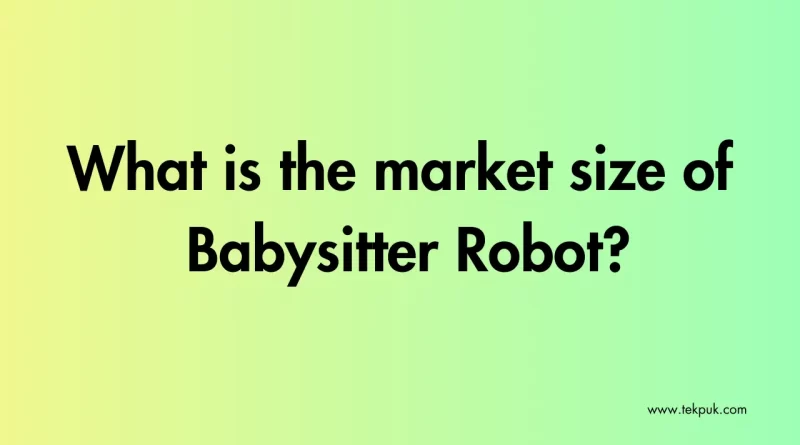What is the market size of Babysitter Robot?
In today’s fast-paced world, where juggling work and family life has become increasingly challenging, the demand for innovative solutions to assist with childcare and household management is on the rise. Many parents are turning to the concept of “Babysitter Robots” as a potential answer to their needs. But What is the market size of Babysitter Robot? In this article, we will delve into this intriguing technology, exploring its current market size, projected growth, key industry players, technological advancements, and the impact on the workforce. Join us on this journey to understand the evolving landscape of Babysitter Robots and how they are transforming the way parents balance their responsibilities.
What is the market size of Babysitter Robot
Babysitter robots are a fascinating innovation, designed to cater to the needs of parents who seek assistance in childcare and home management. These automated companions have been making waves in recent years, but what exactly is the market size of babysitter robots, and where is this industry headed?
Introduction to Babysitter Robots
Definition and Purpose
Babysitter robots are robotic devices programmed to provide childcare and perform various tasks around the house, allowing parents to multitask efficiently. They offer services like monitoring children, assisting with homework, and even cooking simple meals.
Growing Need for Babysitter Robots
As the modern lifestyle becomes increasingly hectic, more parents are turning to babysitter robots to ease the demands of parenthood. The need for these machines has grown substantially, making it a thriving market.
Benefits and Concerns
Babysitter robots provide several advantages, such as enhancing children’s learning experiences and improving household efficiency. However, concerns about privacy, security, and their impact on human interaction remain.
Market Size and Growth
Current Market Size
The current market size of babysitter robots stands at a substantial figure, reflecting the increasing demand for these devices. This market is continually expanding.
Projected Growth
Experts predict robust growth in the babysitter robot industry. Factors like technological advancements and changing lifestyles contribute to this anticipated expansion.
Factors Driving Market Expansion
The need for dual-income households, an aging population, and the desire for a more convenient lifestyle are among the significant factors propelling the growth of the babysitter robot market.
Key Players in the Industry
Leading Companies in Babysitter Robot Manufacturing Several prominent companies are at the forefront of babysitter robot manufacturing, each bringing unique innovations to the market. Names like RoboCare, iRobot, and Blue Frog Robotics are making waves.
Technological Advancements
Innovations in Babysitter Robot Technology
Babysitter robots are becoming increasingly sophisticated, with features like facial recognition, voice activation, and adaptive learning algorithms. These advancements are enhancing their capabilities.
How AI is Revolutionizing the Industry
Artificial intelligence is a driving force behind babysitter robot technology, enabling these robots to adapt to the needs of both parents and children more effectively.
Market Challenges
Safety Concerns
The safety of children is paramount, and ensuring that babysitter robots do not pose risks is a critical challenge that the industry must address.
Ethical Dilemmas
As babysitter robots become more advanced, ethical questions arise regarding their role in child development and the potential replacement of human caregivers.
Regulatory Framework
The industry requires clear regulations to guarantee the safe and responsible use of babysitter robots. This remains a work in progress.
Consumer Adoption
Factors Influencing Adoption
The willingness of parents to adopt babysitter robots depends on various factors, including trust, affordability, and cultural acceptance.
User Experiences and Reviews
Feedback from parents and children who have used babysitter robots can significantly influence the adoption rate and shape the industry’s future.
Market Trends
Customization and Personalization
Personalized experiences and tailor-made features are becoming increasingly popular in the babysitter robot market, allowing parents to adapt robots to their unique needs.
Integration with Smart Homes
The integration of babysitter robots with smart home systems is a trend that enhances convenience and efficiency for families.
Cost and Accessibility
The affordability and accessibility of babysitter robots will continue to be vital factors in the industry’s growth.
Impact on the Workforce
Job Displacement and Job Creation
The introduction of babysitter robots may displace some traditional jobs in the childcare industry while creating new opportunities in robot manufacturing and maintenance.
Economic Implications
The economic implications of a thriving babysitter robot industry extend to various sectors, including education, healthcare, and technology.
Future Prospects
Potential Developments in Babysitter Robot Technology
The future holds exciting possibilities for babysitter robots, with advancements in AI, machine learning, and human-robot interaction.
Market Evolution
The babysitter robot market is expected to evolve in response to changing societal needs, technological advancements, and regulatory developments.
Conclusion
In conclusion, the market size of babysitter robots is substantial and expected to grow significantly. This innovative industry is driven by the increasing demands of modern life, technological advancements, and shifting lifestyles. However, it also faces challenges related to safety, ethics, and regulations. The impact on the workforce and the future prospects of this industry are worth keeping an eye on.
FAQs
Q1. Are babysitter robots safe for children?
Ans. Babysitter robots are designed with safety in mind, but their safety depends on proper use and monitoring. Parents should exercise caution and ensure their child’s well-being.
Q2. Can babysitter robots truly replace human caregivers?
Ans. While babysitter robots offer valuable support, they cannot replace the emotional and interpersonal connection provided by human caregivers.
Q3. How affordable are babysitter robots?
Ans. The cost of babysitter robots varies, but there are options available to suit different budgets. Prices may decrease as the industry grows.
Q4.What are the ethical concerns related to babysitter robots?
Ans. Ethical concerns revolve around issues like child development, privacy, and the potential isolation of children due to excessive reliance on robots.
Q5. What is the future of babysitter robots?
The future of babysitter robots looks promising, with continuous technological advancements and evolving market trends. This industry is likely to become an integral part of modern parenting.




